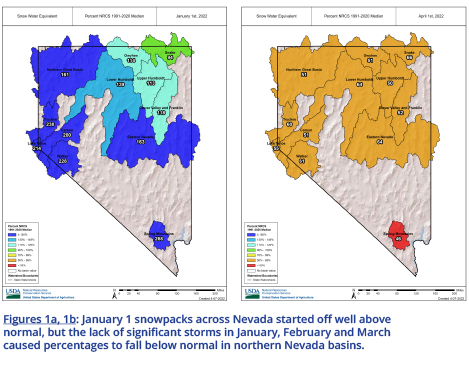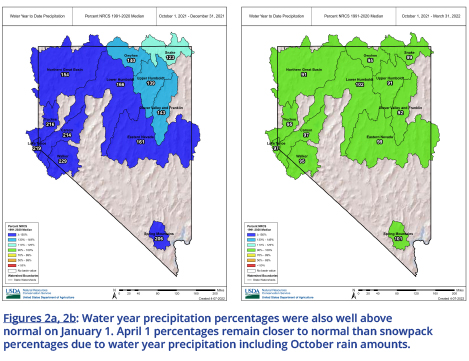 Each year the USDA, Natural Resource Conservation Service (NRCS) snow survey and streamflow forecasting program tracks water supply conditions to meet the needs of the public.
Each year the USDA, Natural Resource Conservation Service (NRCS) snow survey and streamflow forecasting program tracks water supply conditions to meet the needs of the public.
Snowpack, precipitation, air temperature and soil moisture are monitored by the agency’s network of 90 SNOTEL (Snow Telemetry) weather stations distributed across Nevada and the eastern Sierra. Additionally, snow surveyors collect snow tube measurements at an additional 65 snow courses. These data are used by hydrologists at the NRCS National Water and Climate Center to produce seasonal streamflow forecasts to help water managers and water users plan for the coming summer.
From January through May, SNOTEL data and streamflow forecasts are summarized in the Nevada Water Supply Outlook Report which seeks to inform customers how the water year is shaping up. Since 2018, this report has also included a Rangeland Conditions section produced in cooperation with the Nevada State Rangeland Management Specialist.
Below are some ways the snow survey program can serve you:
- Learn more about the Nevada snow survey by watching the new snow survey video: youtube.com/watch?v=gWm5TeASLY8
- Join the Nevada Water Supply Outlook Report subscription list: go.usa.gov/xz5Fk
- Visit NRCS Nevada Snow Survey web pages to see current conditions: go.usa.gov/xz5F8
- Request or attend a snowpack and water supply presentation (opportunities are noted in the Water Supply Outlook Reports)
- Request a custom SNOTEL webpage or data report to meet specific needs
2022 Water Supply Conditions Summary
Based on October and December measurements, water year 2022 started with a boom, but since the start of January, precipitation totals have been trending strongly towards bust. A strong, early-season atmospheric river in October brought record rain amounts across Nevada for the month. SNOTEL stations in the eastern Sierra basins received 5 to nearly 20 inches of precipitation in October. Other parts of northern Nevada also did well with monthly amounts of 2.5 to 7 inches being measured. November was quiet with below normal precipitation, but storms returned in December and SNOTELs in the eastern Sierra measured a record increase in snow water for the month (Fig. 1a, 1b).
January 1 snowpacks in the Sierra were over 200% of median. December snow accumulation in other parts of northern Nevada did not set records but were enough to produce an above normal January 1 snowpack. Unfortunately, from New Year’s through March, the storm track has mostly bypassed Nevada. Precipitation totals from January through March ranked as the driest on record at all SNOTEL sites in the eastern Sierra. Most sites throughout the rest of northern Nevada were also either driest or second driest for the three-month period. Most basins received more precipitation in October than during all of January, February and March combined (Figures 2a, 2b).
With little precipitation since the start of the calendar year, snowpack and water year precipitation percentages which were so strong on January 1 could not keep pace with normal amounts and percentages fell. Basin snow water amounts reached 67-74% of the median peak amounts in the Sierra basins, and 62-68% of the median peak for the Northern Great Basin, Humboldt Basin, Clover Valley and Franklin River Basin, and Owyhee Basin. The Snake Basin and Eastern Nevada each ended up with peak snowpacks of 78%. The Spring Mountains were the only part of Nevada with an above median peak snowpack this winter. Snow peaked in the Spring Mountains on January 7 at 143% of normal, which was two months earlier than normal. April first is normally when basin snowpacks peak in terms of water content, but this year all basins had already experienced significant melt by that time. April 1 snowpack percentages were just 46-66% of median this year, compared to 60-125% last year. April 1 water year precipitation percentages are higher and near normal because they include the rain that fell in October.
One bright spot this water year is that soil moisture under the snow has been above normal. October rains saturated soils and that moisture got locked in when the snow fell. Moist soils should help improve runoff efficiency this spring as the snow melts. This is especially true in the Sierra where winter streamflow has remained strong.
Last year snow fell on dry soils and the spring runoff was inefficient because the dry soil soaked up snowmelt. Unfortunately, snowpacks are smaller than last year, especially in the Humboldt Basin and other portions of northern Nevada, so amount of snow to melt is unlikely to produce the volume of runoff needed to meet demands.
April 1 NRCS streamflow forecasts for April-July runoff are only 12-72% of the new 1991-2020 medians.
To put forecasts in perspective, most April 1 50% exceedance forecast volumes rank near to below the 20th percentile of historic observed flows. If conditions continue to be dry, the 70% exceedance forecasts are more likely and those rank well below the 10th percentile in some areas.
April-July flows in the Humboldt Basin could be near record minimums if dry conditions persist. A table of all April 1 streamflow forecasts is available on the Nevada Snow Survey website, go.usa.gov/xznxS
Continue reading to find out how the NRCS’ switch from stating data as a percent of median compares to previous years when streamflow forecasts were presented as a percent of average (Fig. 3, page 16).
New 1991-2020 Normals
Starting this water year, the NRCS updated its 30-year normals period from 1981-2010 to 1991-2020. The agency also made the median the official normal for all data types. Normals are used to represent data as a percent of normal. Changing normals impacts percentages and requires a recalibration. Most 1991-2020 medians for snow, precipitation and streamflow in Nevada are less than 1981-2010 normals. A smaller normal produces a larger percentage. Due to the boom-bust hydrologic cycle in the Great Basin, streamflow percentages based on median are larger than those based on averages. A forecast percentage near to above 100% of median may seem favorable, but the same volume expressed as a percent of average can easily be well below normal. Visit the Nevada and Eastern Sierra Normals Dashboard (https://go.usa.gov/xz5FX) and watch the 15-minute YouTube presentation for an overview about how changing normals impacts Nevada (Fig. 4, page 17).
Rangeland Conditions
The Great Basin and Mojave Desert have a winter-spring dominated precipitation pattern, so plant growth starts early, usually in late January and early February while temperatures are cool and soil moisture is high. By mid-to-late June, most upland range species have produced and dispersed their seed, thus completing their life cycle. With the hot summer temperatures, the plants enter dormancy and leaves drop off or die back. Some of the shrubs in the Aster family produce flowers and seeds later in the summer (sagebrush- Artemisia spp., rabbitbrush – Ericameria spp.), but most of their stem and leaf growth occurs earlier in the year. Some shrubs and grasses have the ability to break dormancy with late summer rains and even flower again. Snow cover in northern Nevada is important for the shrubs because they typically have long, deep tap roots and shallow lateral roots. The slow melting of snow provides moisture deep in the soil profile and as the surface soils dry out, the roots start drawing moisture deeper in the profile allowing shrubs like sagebrush and rabbitbrush to complete their growth cycle.
Nevada rangelands are no stranger to drought conditions. Last year, drought effects were felt across Nevada by ranchers both in rangeland production and reduced harvested forage on croplands due to the below normal reservoir levels and stream flows used for irrigation. By the end of last summer, drought impacts were extreme to exceptional across much of Nevada as shown on the September 28, 2021 US Drought Monitor Map. Thanks to record breaking October rains and an above normal New Year’s, winter snowpack drought status improved by January 1. Unfortunately, precipitation from January through March was below normal and drought status this spring has begun to worsen as Nevada transitions back to the dry season (Figures 5a, 5b, page 17).
The April 5, 2022 US Drought Monitor Map shows that all of Nevada is experiencing severe to exceptional drought conditions. Rangeland production in Nevada runs from approximately September to June, when the majority of moisture is utilized by rangeland plants. Above normal April through June precipitation could still help improve conditions on the range. You can assist the authors of the US Drought Monitor by submitting local drought observations. Local reports help the authors accurately reflect drought impacts across the state. Since some Farm Bill assistance programs are dependent on the US Drought Monitor, reporting how your operation is being impacted can help the entire agricultural community weather this drought. Observations can be submitted online at: https://droughtimpacts.unl.edu/Tools/ConditionMonitoringObservations.aspx
There is a new tool allowing producers to visualize and analyze vegetation data called Rangeland Analysis Platform (RAP). (See image top right page 17.) It is a web-based application that allows producers to examine trends at pasture, ranch, watershed and broader scales. When analyzing a grazing plan or executing a contingency grazing plan due to drought, RAP allows you to estimate the 16-day aboveground biomass production. There are other key features including tracking changes in annual herbaceous, shrub, tree vegetation cover along with bare ground. If you are concerned with annual invasives and the expansion, especially during drought years, this application takes a deep dive in to fire probability which is closely correlated to annual invasive abundance. Have you wanted to look at historical imagery of your operation or a field? That too is an available tool within RAP where you can check out side-by-side comparisons sourced from the United States Geological Service. Here is a link to the application: https://rangelands.app/ which has great tutorials on how to use the free service.
USDA Natural Resources Conservation Service (NRCS) has a mission to improve the health of the nation’s natural resources while sustaining and enhancing the productivity of American agriculture. NRCS achieves this by providing voluntary assistance through strong partnerships with private landowners, managers, and communities to conserve, protect, restore, and enhance the lands and waters upon which people and the environment depends.
The Environmental Quality Incentives Program (EQIP) provides financial and technical assistance to agricultural producers and non-industrial forest managers to address natural resource concerns and deliver environmental benefits such as improved water and air quality, conserved ground and surface water, increased soil health and reduced soil erosion and sedimentation, improved or created wildlife habitat, and mitigation against drought and increasing weather volatility.
This voluntary conservation program helps producers make conservation work for them. Together, NRCS and producers invest in solutions that conserve natural resources for the future while also improving agricultural operations.
Through EQIP, NRCS provides agricultural producers with financial resources and one-on-one help to plan and implement improvements, or what NRCS calls conservation practices. There are natural resource concerns we call SWAPAH – soil, water, air, plant, animal and human concerns which we address through producer’s voluntary implementation of conservation practices. Applying conservation practices such as prescribed grazing plans, livestock water developments, and fences to better manage riparian areas ensure rangelands are resilient to impacts during drought years. If you would like more information on the EQIP program please contact your local NRCS office or visit the link: nrcs.usda.gov
By Jeff Anderson, Nevada NRCS Water Supply Specialist and Dusty Jager, Nevada NRCS State Rangeland Management Specialist





